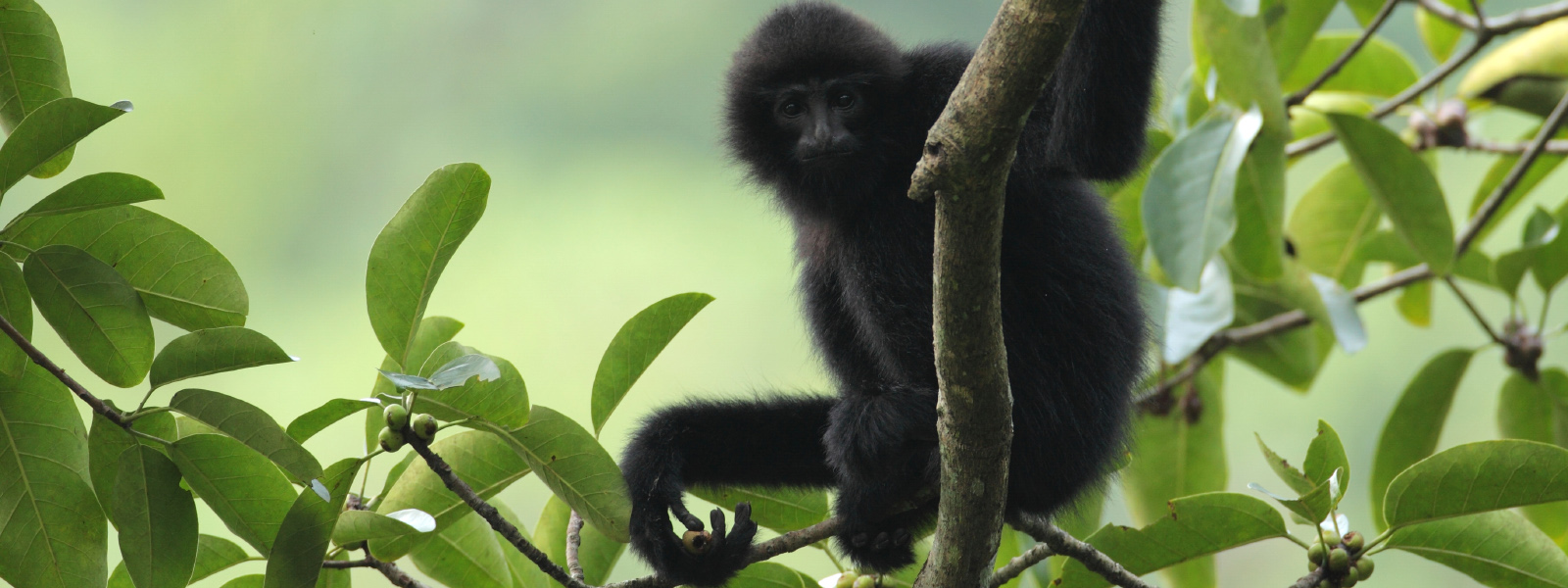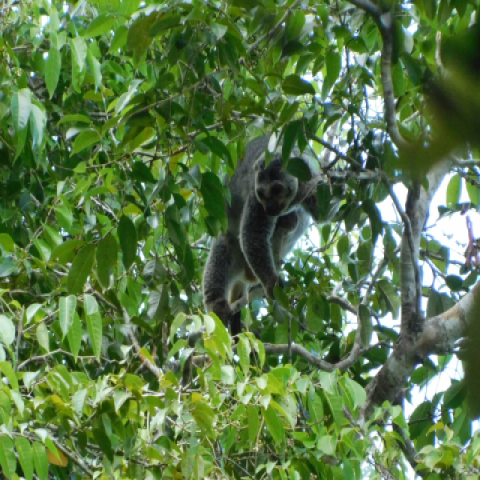Conservation Actions
This species is listed on CITES Appendix I, and in annex IB of the Decree No. 32/2006 ND-CP in Viet Nam. In China, all gibbons are protected as National First Class Protected Animals. Since rediscovery, the entirety of the species range has been protected through development of protected areas; through the Cao Vit Gibbon Conservation Areas in Vietnam (designated in 2007) and Bangliang Nature Reserve in China (designated in 2009). Bangliang Nature Reserve was upgraded to a national nature reserve in 2014.
A trans-boundary MoU has been signed (most recently in 2015) by Cao Bang Provincial Department of Agriculture and Rural Development, Viet Nam, and Quangxi Forestry Department, China, to improve trans-boundary coordination between protected area authorities. Meetings of patrol teams occur on a regular basis at the international border and government authorities convene every one to two years to discuss matters of mutual concern in addition to being available for immediate contact through other means on a case by case basis. For example, in 2015, Management Boards convened at the border to address the findings of Chinese hunters illegally entering the Vietnamese protected area. Both protected areas have active enforcement teams, including community-based conservation teams comprising local community members who are trained in patrol work.
Forest restoration activities, supported by FFI in China and PRCF in Viet Nam, aim to address the issue of forest degradation within the core areas of gibbon distribution. This involves both Assisted Natural Regeneration and reforestation activities. Activities relating to reduction of further impact on forest quality have also been conducted by FFI, including provision of fuel efficient stoves to reduce quantities of fuel wood extracted by local communities, cattle exclusion fencing, a goat buyback scheme and provision of elephant grass for silage to reduce grazing pressure on regenerating forests and replacement of timber waterwheels with metal waterwheels. In China, it has been proposed that strict conservation areas be imposed in areas close to gibbon habitat.
A trans-boundary conservation action plan is under development at the time of writing, based on stakeholder consultations at the village, provincial and international levels. This action plan will guide conservation interventions for the period of 2015-2020. Key activities will include: continued forest restoration to ensure the growing population will have suitable areas to expand into, continued measures to reduce further forest degradation, continued enforcement activities, increasing the size of the protected area and ensuring corridors to additional potential habitat, population and demographic monitoring and additional research activities such as genetic, habitat and viability analyses. Engaging local people in the buffer zones of the protected areas and provision of alternative livelihood options will also be key for addressing long-term impacts on the protected areas and the gibbons.
Action Plan
The Conservation Status of Gibbons in Viet Nam
Location Information
There is only one known population restricted to a small karst forest (about 2,500 ha) in Trung Khanh District, northern Cao Bang province, and adjacent forest in Jingxi County, Guangxi (Chan et al. 2008, Rawson et al. 2011, Fan et al. 2013a). Additional surveys in Viet Nam, in locations with historical records, have returned no other populations, and it is now thought to be extirpated across the rest of its former range, although there is a possibility that some individuals still remain in isolated pockets of inaccessible karst forest (Rawson et al. 2011). Historically, Nomascus nasutus was distributed from southern China to northern Viet Nam, extending south to the Red River (Rawson et al. 2011). The species' range seems to have formerly extended from Ha Long Bay south to the Red River delta; gibbons of some species formerly lived in adjacent areas of southeastern China (Guangdong and Guangxi provinces), but are thought to have almost completely disappeared from there during the 1950s (Geissmann et al. 2000).
Geographic Range
Extant
China, Viet Nam
Population Information
This species was thought to be Possibly Extinct (Geissmann et al. 2000), but a surviving population was found in 2002 in Trunh Khanh district, Cao Bang province, Viet Nam (Rawson et al. 2011). This population was surveyed several times to determine its size and distribution (Rawson et al. 2011, Duc et al. 2014, 2015), with each survey suggesting a slightly larger population than the last. In 2006, three more groups with 18 individuals were found on the Chinese side of the border (Zhou et al. 2008), confirming that this was a trans-boundary population. A trans-boundary population survey conducted in September 2007 recorded 18 groups with about 110 individuals (Rawson et al. 2011) and is believed to be close to a full census. The survey approach was replicated in 2012, although only from listening posts in Vietnam, and returned at least 129 individuals in 24 groups (Cuong et al. 2012), suggesting that the population is increasing. Population monitoring of three groups in China showed that females breed well. The inter-birth interval was 31.0 ± 6.6 months (range: 23-38 months, N =8) and 33.5 ± 5.5 months (range: 23-38 months, N =6) (Yin et al. 2016). A new group formed in China in 2015 (Wei et al. 2017).
Threats
The main threat to this species, given its restricted range, is habitat loss and degradation (Fan et al. 2013a, Rawson et al. 2011, Hoàn et al. 2016). What little remains of the species' habitat is under pressure from fuel wood collection, cultivation in valley bottoms and livestock grazing, especially of goats, by local Vietnamese and Chinese ethnic minorities. Hunting of this trans-boundary gibbon population has been controlled with the gazettement of protected areas in both Viet Nam and China and subsequent enforcement, although hunting of other taxa does still occur. It should be noted that even occasional hunting events of gibbons would be very detrimental to the species long-term viability and continued vigilance is required. Problems intrinsic to small, single populations may pose a significant long-term risk to population viability through inbreeding, disease outbreaks, extreme weather events and fires and climate change. A recent Habitat and Population Viability Analysis exercise by (Fan et al. 2013) suggested that the last remaining population of these gibbons may be reaching carrying capacity, making habitat restoration a significant priority.
IUCN Red List Account Link
Please click here to see the species' IUCN Red List Account page.Photo Credits
Zhao Chao - Fauna and Flora International (category and featured image)





